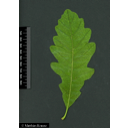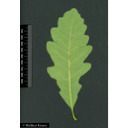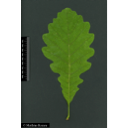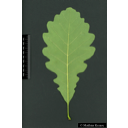Useful information about the taxon (species, subspecies, variety...)
Quercus bicolor Willd. 1801
Fagaceae
(APG IV)Swamp white oak
Taxon concept: The Plant List (2014), version 1.1
Distribution: East Canada; United States: northeastern, northeastern and southern States of the Great Plains, southeast, Florida
Size: 18 - 23 (m)
Flowering period: V - VI
Quercus bicolor Willd. - Accepted: Quercus bicolor Willd. bei Zander 2008; Familie: Fagaceae (Zander 2008)Quercus bicolor Willd. - Accepted: Quercus bicolor Willd. bei The Plant List (2014), version 1.1; Familie: Fagaceae (APG III)
- Flowers
- monoecious
- Flower ecology
- wind-pollinated (anemophilous)
- Life form
- tree
- Leaves
- obovate, upper surface darkgreen, lower surface silvery-white tomentose
- Foliage persistence
- deciduous
- Fruits
- acorns, 19-32 mm long
- Fruit ecology
- gravity-dispersed (barochorous), animal-dispersed (zoochorous) and water-dispersed (hydrochorous)
- Soil conditions
- on periodically inundated, poorly drained, shallow alluvial soils
- Root type
- usually shallow root system
- Natural occurrence (habitat)
- broad stream valleys, lake margins, margins of ponds and sloughs
- Vegetation typ and synecology (plant community)
- temperate mixed hydromesophytic forests; in the following forest communities: Black Ash-American Elm-Red Maple, Bur Oak, Silver Maple-American Elm, and Pin Oak-Sweetgum
- Natural propagation (all types)
- vegetative reproduction through stump sprouting
- Comments
- hypogeal germination
- Life span
- long-lived (to 350 years)
- Usage
- wood is used for furniture, cabinetry, interior trim, flooring, boatbuilding, and barrels
- Phytopathogenic organisms
- susceptible to the oak wilt fungus Ceratocystis fagacearum
- Bark
- dark brown to black
Deepdale Trees Ltd. (2009-2019): Tilia x euchlora. See: http://www.deepdale-trees.co.uk/trees/information/Tilia-x-euchlora-fact-sheet.pdf; Erhardt, W., Götz, E., Bödeker, N. & Seybold, S. (2008): Der große Zander. Enzyklopädie der Pflanzennamen. Band 2. Arten und Sorten. Eugen Ulmer KG, Stuttgart (Hohenheim), 18. Aufl., 2103 S.; The International Plant Names Index (2009). Published on the Internet http://www.ipni.org; Courtesy to IPNI, 2009. Exported from IPNI at date: 2009-09-22 20:17:51;
Diese Webseite verwendet Google Maps, um Karten und Standorte von Pflanzen in den Hohenheimer Gärten anzuzeigen. Dadurch werden unter Umständen Daten an Google weitergeleitet, was mit einer Verarbeitung Ihrer personenbezogenen Daten verbunden sein kann. Die Datenschutzerklärung von Google finden Sie hier: Datenschutzerklärung von Google
| Sex | Standort | Accession number | Planting year | Donation | IPEN | Lat. | Long. |
|---|---|---|---|---|---|---|---|
| Parzelle E | EG-E-148-18787 | 1991 | + | XX-0-HOH-EG-E-148-18787 | 48,7103421259 | 9,2080916676 | |
| Parzelle E | SP-EB-081-17025 | 2016 | XX-0-HOH-SP-EB-081-17025 | 48,7108279672 | 9,2118005751 | ||
| Parzelle H | SP-HB-028-18875 | 2018-08 | + | XX-0-HOH-SP-HB-028-18875 | 48,7105662777 | 9,2130294717 |




